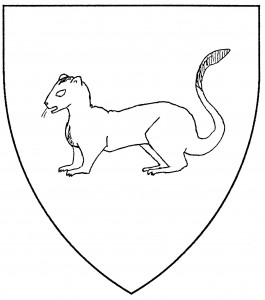The ermine is a skinny beast of the mustelid family. It’s technically a “stoat” or “weasel”; and it is sometimes so blazoned, as in the canting arms of Birtwistle, 1478 [Woodcock & Robinson 81]. In heraldry, the term “ermine” refers to the stoat in its winter coloration, pure white with a black-tipped tail; this is its “proper” coloration. It’s found in this form as the badge of the Dukes of Brittany [Gayre, Heraldic Standards, p.93].
The ermine was valued for its silky white fur, which in time became the ermine furs of heraldry. It was also one of the symbols of the Virgin, not only because of its pure white fur, but because of a medieval legend that the ermine conceived through its ear.
Similar in form to the ermine are such beasts as the “otter”, found in the canting arms of Ottyr, c.1460 [RH]; the “marten”, found in the arms of von Muggenthal, 1605 [Siebmacher 81]; and in Society heraldry, the “ferret”, the “mink”, and the “polecat”. Though zoologically distinct, they are heraldically equivalent to the ermine. All ermine-like beasts seem to be statant by default; this is uncertain, so it’s best to blazon the posture explicitly. (The illustration shows an ermine statant.) For related charges, see mongoose. See also ermine spot.
Rima of Rockridge bears: Gules, an ermine statant guardant proper.
Friedrich von Waffen bears: Argent, three ferrets statant guardant in pale sable.
Lorimel the Gentle bears: Vert, an otter sejant erect Or.
Donatien Delaborde bears: Per fess argent and azure, two weasels statant counterchanged.
Alrik Eriksson Mård bears: Gyronny azure and argent, a marten rampant coward contourny sable.
